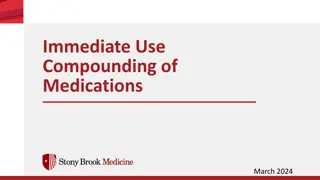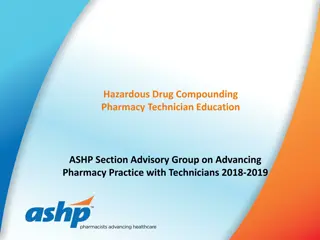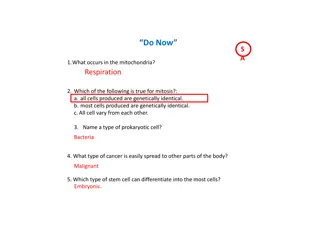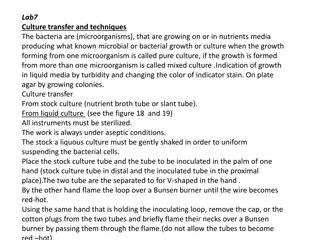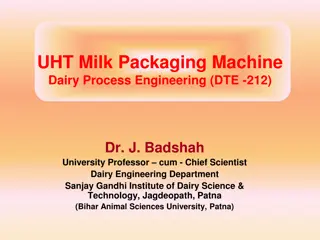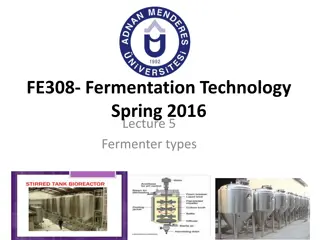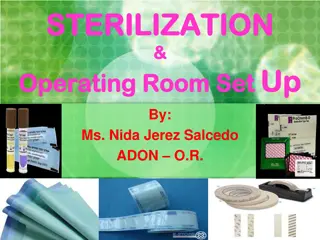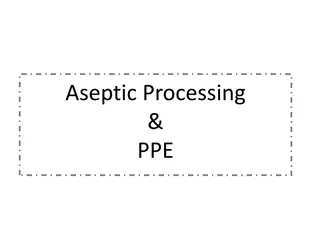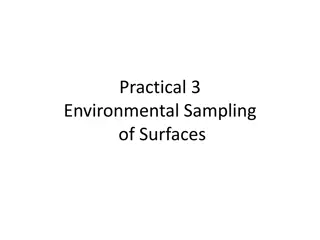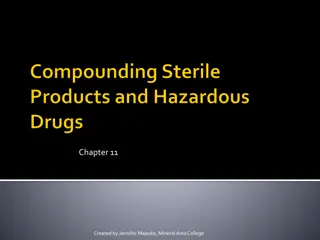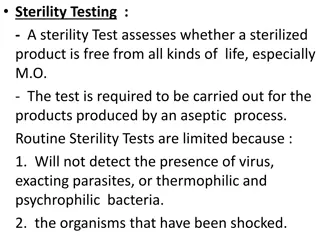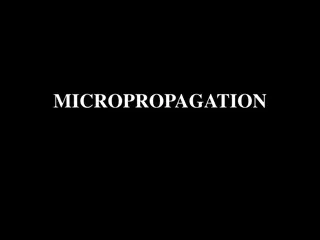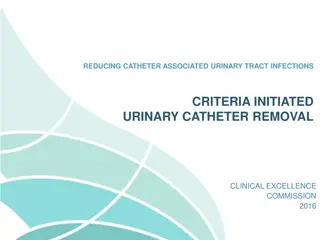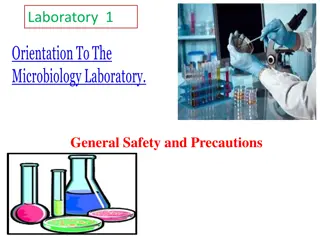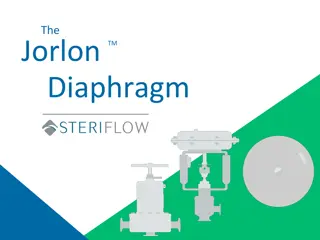Standard Precautions in Dental Settings
Standard Precautions in Dental Settings emphasize the importance of hand hygiene, proper use of personal protective equipment, aseptic techniques, clinical asepsis, and environmental surface disinfection to control infections. Adherence to these precautions minimizes the risk of spreading microorgan
0 views • 21 slides
Central Venous Catheter Access Management in Brampton and Surrounding Areas
Nurse-led Outreach Team in Brampton, North Etobicoke, West Woodbridge, Malton, and Bramalea provides education on managing central venous catheter access devices like PICCs. Learn about preventing infections, post-insertion care, types of CVADs, and aseptic techniques for PICC line management.
1 views • 20 slides
Immediate Use Compounding of Medications - Guidelines and Procedures
Immediate Use Compounding of Medications involves preparing sterile medications outside the pharmacy in urgent situations to avoid delays in patient care. This process requires following specific criteria, maintaining aseptic technique, and ensuring proper labeling. It excludes acts like reconstitut
0 views • 13 slides
Comprehensive Guide to Hazardous Drug Handling for Pharmacy Technicians
This guide covers essential aspects of handling hazardous drugs (HD) in a pharmacy setting, including types of HDs, risks associated with exposure, policies and procedures, ordering and stocking, personal protective equipment usage, aseptic practices, containment, and disposal procedures. It emphasi
0 views • 30 slides
Safety Measures for Growing Microorganisms in the Laboratory
In the laboratory, it is crucial to use aseptic techniques when dealing with microorganisms to prevent contamination and ensure safe growth. Understanding the importance of agar plates, Petri dishes, and incubators in creating optimal conditions for microbial growth is essential. By following proper
0 views • 25 slides
Understanding Plant Tissue Culture: Methods and Requirements
Plant tissue culture involves the in-vitro culture of plant explants under aseptic conditions, covering cell, organ, and suspension cultures. This process, pioneered by German botanist Gottlieb Haberlandt, relies on the totipotency of plant cells. Key requirements include laboratory organization, su
0 views • 18 slides
Bacterial Culture Transfer Techniques and Growth Indicators
Bacterial cultures can be transferred using aseptic techniques to ensure purity. Growth indicators such as turbidity in liquid media and colonies on agar plates signify microbial growth. Proper sterilization and handling of instruments are crucial in the process. Techniques like streaking on agar pl
1 views • 4 slides
UHT Milk Packaging Machine and Process Engineering Overview
UHT milk packaging machines like Tetra Brick Aseptic filling machines ensure aseptic conditions for packaging dairy products. These machines use multi-layered packaging material and feature components like ASU unit for continuous production, Strip Applicator to prevent product contamination, and per
1 views • 16 slides
Understanding Fermenter Design and Functionality
The fermenter is essential in the fermentation process, providing a controlled environment for biomass and product yields. It enables aseptic fermentation, optimal mixing, and aeration without excessive power consumption. Key functions include temperature control, pH regulation, and minimizing evapo
1 views • 36 slides
The Role of ESR and CRP in Preoperative Workup for Total Knee Arthroplasty
Preoperative assessment for primary total knee arthroplasty should consider including ESR and CRP levels as routine tests due to their accuracy in diagnosing periprosthetic joint infection (PJI). Elevated postoperative ESR/CRP levels can serve as predictors of PJI, aiding in prompt diagnosis and tre
1 views • 26 slides
Understanding Sterilization and Aseptic Techniques in Operating Room Setup
Explore the methods and processes of sterilization, principles of aseptic techniques, and operating room setup for patient safety. Learn terminologies related to sterilization, asepsis, sepsis, antiseptics, and disinfection to ensure a sterile environment for medical procedures.
0 views • 103 slides
Understanding Plant Tissue Culture: Techniques and Applications
Plant tissue culture involves maintaining and growing plant cells, tissues, or organs in artificial mediums under controlled conditions. It allows the regeneration of whole plants from small plant parts or cells. Hormones like auxins, cytokinins, and gibberellins are used in the process. Proper envi
3 views • 5 slides
Understanding Aseptic Processing and Contamination Control in Cleanroom Environments
Aseptic processing involves maintaining a sterile environment to prevent contamination in cleanroom settings. The presence of non-viable and viable particulate contamination, such as dust and live microorganisms, poses challenges. Sources of contamination include equipment, structures, surfaces, and
0 views • 29 slides
Guide to Environmental Surface Sampling Techniques
Understanding the importance of environmental surface sampling is crucial for ensuring hygiene and safety. This guide covers key aspects such as pre-sampling considerations, aseptic techniques, major sampling methods like RODAC plate, swab, and wipe methods, along with detailed procedures for each m
1 views • 16 slides
Understanding Equipment and Techniques in Intravenous Preparation
Explore the role and function of equipment like syringes, needles, IV sets, catheters, etc., in IV preparation. Learn about IV solution characteristics, aseptic technique in pharmacy, handling hazardous drugs, and quality assurance programs in hospitals. Discover the importance of aseptic technique
0 views • 69 slides
Understanding Sterility Testing in Pharmaceutical Production
Sterility testing is crucial in assessing the absence of viable organisms in sterilized products. While it has limitations such as not detecting certain types of contaminants, various methods like direct inoculation, membrane filtration, and introduction of concentrated culture medium are employed t
0 views • 13 slides
Understanding Micropropagation: A Clonal Propagation Method
Micropropagation is a popular method for vegetative propagation in plants, providing genetically identical copies through aseptic tissue culture techniques. This technique allows for mass production of true-to-type plantlets in a short time, crucial for the commercial propagation of horticultural cr
0 views • 42 slides
Strategies for Preventing Catheter-Associated Urinary Tract Infections
Catheter-associated urinary tract infections are a common healthcare-associated infection, with 80% of hospitalized patients experiencing a urinary tract infection. This article provides guidelines for preventing CAUTIs, such as only catheterizing patients when necessary, maintaining asepsis, practi
0 views • 20 slides
Laboratory General Safety and Precautions
Microbiology involves the study of microorganisms such as bacteria, fungi, viruses, and parasites. It is crucial to maintain strict safety protocols in the laboratory to prevent contamination and ensure the well-being of individuals handling these potentially pathogenic organisms. Rules like wearing
0 views • 26 slides
Enhancing Pharmaceutical Process Reliability with JorlonTM Diaphragms
Aseptic valve components are crucial in the pharmaceutical industry, especially the diaphragms in automated control valves. JorlonTM Diaphragm, a pure PTFE material, provides a sterile barrier, increasing valve life and reducing downtime risks due to failures. Tested for durability, JorlonTM offers
0 views • 16 slides
Comprehensive Guide to Aseptic Gowning by Dr. Chander Arora
Explore a detailed overview of aseptic gowning practices by Dr. Chander Arora, covering topics such as definitions, purposes, good practices, and step-by-step guidelines for proper gowning levels. Learn the importance of maintaining cleanliness, using personal protective equipment, and following FDA
0 views • 20 slides


